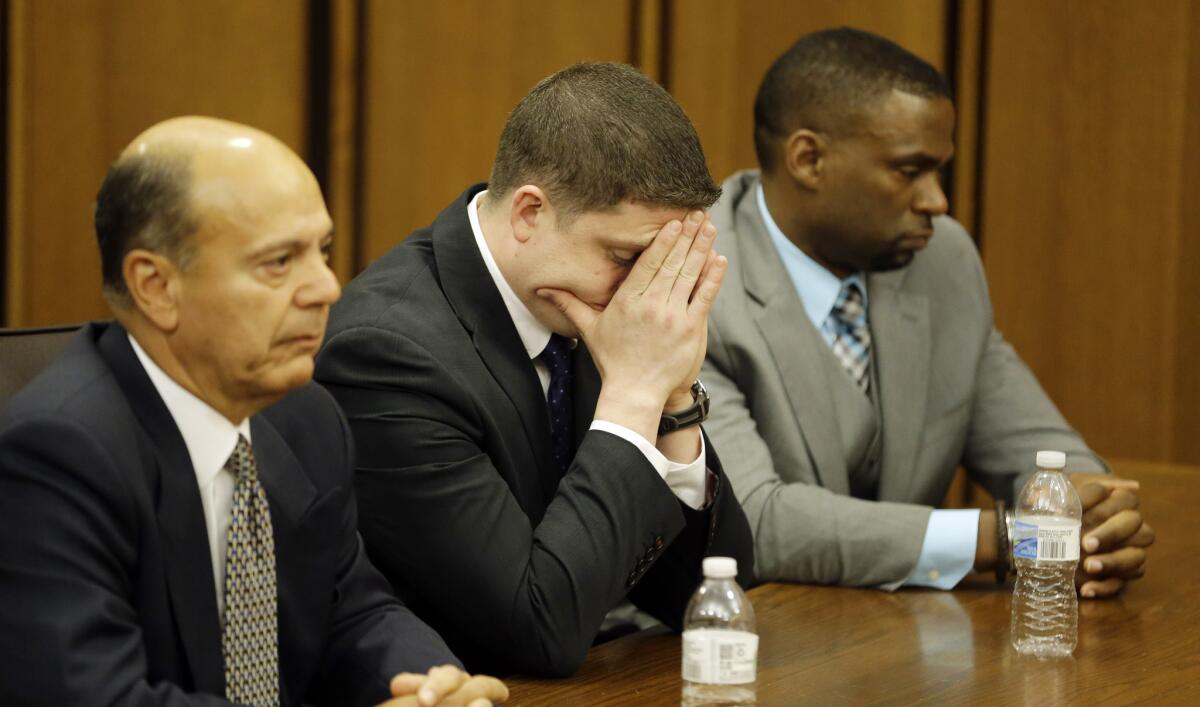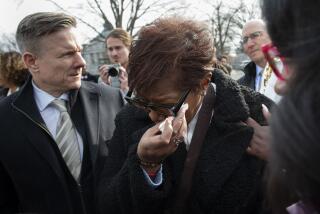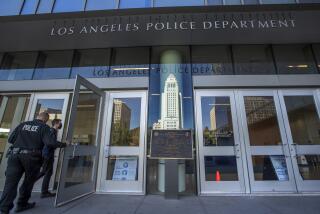Judge acquits Cleveland police Officer Michael Brelo in 2012 killings

Cleveland police Officer Michael Brelo, center, reacts as the verdict is read at his trial. A judge who acquitted him Saturday said he would “not sacrifice” Brelo “to a public frustrated by historical mistreatment at the hands of other officers.”
Saying he would “not sacrifice” a Cleveland police officer to appease a public frustrated with law enforcement, a judge on Saturday acquitted Officer Michael Brelo of manslaughter charges after he shot two unarmed people at the end of a wild 2012 car chase, during which officers fired 137 shots.
“I will not sacrifice him to a public frustrated by historical mistreatment at the hands of other officers,” Judge John P. O’Donnell of the Cuyahoga County Common Pleas Court wrote in the opinion.
Television footage showed Brelo, 31, bursting into tears when the judge declared him not guilty. He was accused of manslaughter for jumping onto the hood of the car and unleashing a barrage of gunfire on Timothy Russell and Malissa Williams, the vehicle’s unarmed occupants. Police fired so many rounds that a crime scene investigator ran out of rods to mark the bullet holes.
An in-house investigation of Brelo and 12 other officers involved in the shooting will continue, Cleveland Mayor Frank Jackson said Saturday, as he urged calm before the release of findings in another potentially explosive case, that of 12-year-old Tamir Rice, who was killed last year by police while holding a toy gun.
After Saturday’s verdict, police said about 9:30 p.m. they had made several arrests on suspicion of felonious assault, aggravated riot and obstructing justice. The department said it would give more detail Sunday about the arrests and any other incidents that took place during the demonstrations.
The case against Brelo began years before the death of Tamir and those of a litany of unarmed black men at the hands of police across the country: Michael Brown, Eric Garner, Freddie Gray. Since then demonstrators in city after city have marched in protest and vented their frustration on social media, helping this relatively little-known Cleveland case become the top trending topic worldwide Saturday morning on Twitter.
On Nov. 29, 2012, Russell led police on a 20-mile pursuit after a gun, police said, was fired at officers near the city’s downtown justice center. No gun was ever found, and prosecutors said the sound was a car backfiring.
During the 22-minute chase, more than 100 officers pursued Russell, firing dozens of shots. Russell’s car was stopped after two police cruisers trapped it in a school parking lot. Prosecutors said Brelo jumped on the hood of Russell’s car and fired at Russell and Williams 15 times from point-blank range. Of the 137 rounds fired by police during the chase, Brelo shot 49.
O’Donnell said it would be impossible to determine that Brelo was directly responsible for the deaths, given the number of shots fired. Autopsies revealed that Russell and Williams were each shot nearly two dozen times, and both suffered multiple fatal wounds.
O’Donnell acknowledged the fear and anger over recent deaths of black men at the hands of police in places with a majority black population, like Cleveland.
“Some say the volatile relationship between police and the community is rooted in our country’s original sin,” he said. “Whether it is or not, that sin won’t be expiated and the suspicion and hostility between the police and people won’t be extirpated by a verdict in a single criminal lawsuit.”
O’Donnell acknowledged the fear and anger over the recent deaths of black men in New York; Baltimore; Ferguson, Mo.; and North Charleston, S.C. That animosity has been fed “not just by stories that attract TV watchers and Internet clickers,” but by the police officers’ actions, he said.
O’Donnell also noted the chaos of the pursuit and the police’s perception that Russell and Williams had fired upon them, and he ruled that Brelo was justified in using deadly force because he believed the pair presented an imminent threat to his life.
The incident sparked a years-long U.S. Department of Justice review of Cleveland police tactics. Federal investigators released their findings last year, ruling that city police routinely used excessive force, needlessly shot residents and used stun guns and chemical sprays to punish, rather than subdue, suspects.
On Saturday, the head of the department’s civil rights division said the agency was conducting a separate review of the Brelo case to determine “what, if any, additional steps are available and appropriate.”
A slew of officers refused to testify at the trial, and others who had been subpoenaed refused to even meet with prosecutors to go over their testimony. Cuyahoga County prosecutor Timothy McGinty accused the union of attempting to insulate Brelo from prosecution, comparing their actions to those of an “organized crime syndicate.”
Brelo, who still faces department discipline, left Cleveland with his wife and two children after the verdict, according to Stephen Loomis, president of the Cleveland Police Patrolman’s Assn. Loomis said he feared that Brelo could be a target for violence if he returned to patrol duty in the city.
“The lengths that McGinty went to to try to win this case are embarrassing. He should be disbarred,” Loomis said. “I can’t imagine how he’s not going to be reprimanded for his antics and the statements that he made.”
City Councilman Jeff Johnson, who is hopeful that Brelo will be fired after the department completes its internal review of the shooting, said the verdict sent a clear message to city residents that police would not be held accountable for their actions in Cleveland.
The argument that Brelo was justified in using deadly force because he feared Russell and Williams had a weapon, Johnson said, could be used against prosecutors reviewing the death of Tamir Rice.
“The hysteria that the cops felt, the fear that the cops felt, was created by themselves,” Johnson said.
More to Read
Sign up for Essential California
The most important California stories and recommendations in your inbox every morning.
You may occasionally receive promotional content from the Los Angeles Times.












